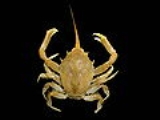
Corystes cassivelaunus
Encyclopedia
Corystes cassivelaunus, the masked crab, helmet crab or sand crab
, is a burrowing crab
of the North Atlantic
and North Sea
from Portugal
to Norway
, which also occurs in the Mediterranean Sea
. It may grow up to 4 centimetres or 1.6 in long (carapace
length). The name "masked crab" derives from the patterns on the carapace which resemble a human face, in a similar manner to heikegani
.
C. cassivelaunus lives buried in sandy substrates, where it feeds on the infaunal invertebrate
s such as polychaete worms
and bivalve molluscs
. It uses its two antennae
to form a breathing tube that allows oxygenated
water down into the substrate. The chelipeds of males are much longer than the body, while those of females are only about as long as the carapace.
Sand crab
The common term sand crab can refer to various species of crustacean:* Crustacea of the superfamily Hippoidea, often known as mole crabs* Crabs of the genus Ocypode, also commonly known as ghost crabs...
, is a burrowing crab
Crab
True crabs are decapod crustaceans of the infraorder Brachyura, which typically have a very short projecting "tail" , or where the reduced abdomen is entirely hidden under the thorax...
of the North Atlantic
Atlantic Ocean
The Atlantic Ocean is the second-largest of the world's oceanic divisions. With a total area of about , it covers approximately 20% of the Earth's surface and about 26% of its water surface area...
and North Sea
North Sea
In the southwest, beyond the Straits of Dover, the North Sea becomes the English Channel connecting to the Atlantic Ocean. In the east, it connects to the Baltic Sea via the Skagerrak and Kattegat, narrow straits that separate Denmark from Norway and Sweden respectively...
from Portugal
Portugal
Portugal , officially the Portuguese Republic is a country situated in southwestern Europe on the Iberian Peninsula. Portugal is the westernmost country of Europe, and is bordered by the Atlantic Ocean to the West and South and by Spain to the North and East. The Atlantic archipelagos of the...
to Norway
Norway
Norway , officially the Kingdom of Norway, is a Nordic unitary constitutional monarchy whose territory comprises the western portion of the Scandinavian Peninsula, Jan Mayen, and the Arctic archipelago of Svalbard and Bouvet Island. Norway has a total area of and a population of about 4.9 million...
, which also occurs in the Mediterranean Sea
Mediterranean Sea
The Mediterranean Sea is a sea connected to the Atlantic Ocean surrounded by the Mediterranean region and almost completely enclosed by land: on the north by Anatolia and Europe, on the south by North Africa, and on the east by the Levant...
. It may grow up to 4 centimetres or 1.6 in long (carapace
Carapace
A carapace is a dorsal section of the exoskeleton or shell in a number of animal groups, including arthropods such as crustaceans and arachnids, as well as vertebrates such as turtles and tortoises. In turtles and tortoises, the underside is called the plastron.-Crustaceans:In crustaceans, the...
length). The name "masked crab" derives from the patterns on the carapace which resemble a human face, in a similar manner to heikegani
Heikegani
Heikegani is a species of crab native to Japan, with a shell that bears a pattern resembling a human face...
.
C. cassivelaunus lives buried in sandy substrates, where it feeds on the infaunal invertebrate
Invertebrate
An invertebrate is an animal without a backbone. The group includes 97% of all animal species – all animals except those in the chordate subphylum Vertebrata .Invertebrates form a paraphyletic group...
s such as polychaete worms
Polychaete
The Polychaeta or polychaetes are a class of annelid worms, generally marine. Each body segment has a pair of fleshy protrusions called parapodia that bear many bristles, called chaetae, which are made of chitin. Indeed, polychaetes are sometimes referred to as bristle worms. More than 10,000...
and bivalve molluscs
Bivalvia
Bivalvia is a taxonomic class of marine and freshwater molluscs. This class includes clams, oysters, mussels, scallops, and many other families of molluscs that have two hinged shells...
. It uses its two antennae
Antenna (biology)
Antennae in biology have historically been paired appendages used for sensing in arthropods. More recently, the term has also been applied to cilium structures present in most cell types of eukaryotes....
to form a breathing tube that allows oxygenated
Oxygenation (environmental)
Environmental oxygenation can be important to the sustainability of a particular ecosystem. Insufficient oxygen may occur in bodies of water such as ponds and rivers, tending to suppress the presence of aerobic organisms such as fish...
water down into the substrate. The chelipeds of males are much longer than the body, while those of females are only about as long as the carapace.

